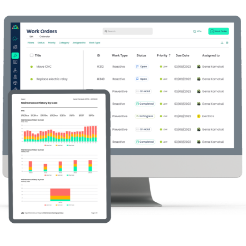
Level up with CMMS Maturity Models
Many organizations proudly say they “have a CMMS,” but ownership alone doesn’t equal effectiveness. The objective measure is how well the CMMS supports the organization’s maintenance strategy, decision-making, and business value as they relate to downtime and labor productivity, as well as spare parts management. This is where maturity models come in. A maturity model provides a structured approach to assessing current capabilities, identifying gaps, and charting a path forward.
Forrester SaaS Maturity Model
The concept of maturity models isn’t unique to maintenance management—it also exists in IT, SaaS, and digital transformation. For example, Forrester’s SaaS Maturity Model outlines adoption stages as ad hoc, opportunistic, standardized, managed, and optimized. These stages are presented as follows:
- Ad Hoc: Fragmented usage with inconsistent adoption.
- Opportunistic: Basic organization and early wins, but still reactive.
- Standardized: Processes are formalized, data is trusted, and metrics drive decisions.
- Managed: Integration with enterprise systems and predictive tools mirrors managed SaaS environments.
- Optimized: Emphasize continuous optimization, alignment with business strategy, and measurable ROI.
By referencing a widely recognized model, such as Forrester’s, maintenance leaders can frame CMMS maturity in terms familiar to executives, helping to justify investment and roadmap decisions.
CMMS Maturity Model: Six Levels (0–5)
Below is a CMMS Maturity Model tailored for organizations in North America (the U.S. and Canada), broken down into six levels (0–5). Each level outlines common characteristics, real-world examples, ROI opportunities, cultural elements, and practical steps to progress. This CMMS maturity model can also be applied to organizations in other parts of the world. The approach to maintenance is entirely reactive, with technicians firefighting unexpected breakdowns and repairs.

Level 0: No System / Ad Hoc Maintenance
This level can be rightly called the baseline level. This is where we begin to establish a foundation for CMMS maturity. This level is characterized by verbal instructions that seem like work orders. It could also include notes on pieces of paper, 3M sticky notes, or whiteboards.
For example, a small food-processing facility relies on the maintenance supervisor’s memory for all equipment schedules, creating significant risks and vulnerability when he is on leave or decides to leave the organization.

Level 0 Risks
- High unplanned downtime.
- Tribal knowledge is concentrated in a few people.
At this level, just implementing a basic CMMS to centralize work orders can reduce downtime by 5–10% generating a positive ROI.
Level 1: Basic CMMS Software
At this level, we at least have the CMMS in place and implemented. The goal is now to get the CMMS to work as intended. In Level 1, work orders are entered into the CMMS, but not consistently. Existing Preventive maintenance (PM) schedules are often ignored. The CMMS software is primarily a digital storage system with limited reporting capabilities, highlighting weak stakeholder buy-in. Thus, the CMMS serves only as a consolation, viewed more as a chore than a tool.
For example, a school district implements a CMMS to log HVAC and custodial requests, but finds that teachers still email staff directly instead of submitting tickets through the CMMS system.
Level 1 Risks
- Data quality issues undermine trust.
- Technicians may resist adoption.
Regular and consistent CMMS usage will itself yield a 10–15% reduction in unplanned downtime and better compliance visibility.
Level 2: Organized and Consistent CMMS Usage
Levels 2 and onwards involve staff who are committed to using the CMMS and buy into its implementation.
- CMMS is used daily by most technicians, who follow procedures.
- Preventive maintenance tasks are scheduled and completed on a regular basis.
- Asset records are up-to-date and tied to work orders.
- Reports are used for compliance and internal tracking.
For example, a mid-sized plastics manufacturer uses its CMMS to ensure all injection molding machines receive PM every quarter. Compliance is substantial, but breakdowns still occur unexpectedly.
Organizations at this level avoid compliance penalties and reduce overtime costs, but struggle to capture deeper financial gains. At level 2, decision-making is still reactive at leadership levels.
Level 2 Risks
- Still largely reactive when unexpected failures occur.
- Reports provide information but not deep insights to make long-term strategic decisions.
Level 3: Data-Driven Maintenance
At Level 3, organizations are becoming increasingly serious about CMMS and their maintenance management processes. Preventive maintenance compliance is high. Reliability metrics are tracked and acted upon. CMMS integrations with other systems (including ERP) are active. At this level, the CMMS provides insights for management decisions as part of a process.
For example, a Canadian utility utilizes CMMS reports to identify pumps with the highest Mean Time to Repair (MTTR), enabling them to prioritize upgrades in the next capital plan.
At Level 3, maintenance costs are reduced by 10–20% because of an improvement in equipment uptime. A data-driven culture builds as technicians rely on reports rather than intuition. There is some risk at this stage involving some users being overwhelmed with the data coming from the CMMS, which they may not be trained to manage.
Level 4: Integrated and Predictive
With Level 4, organizations are entering a truly advanced stage of CMMS. The core is focused on continuous improvement in maintenance management, leveraging a CMMS. At Level 4,
- CMMS integrates with ERP, IoT, and SCADA systems.
- Predictive maintenance models identify issues before they fail.
- Maintenance planning considers asset criticality and lifecycle cost.
For example, a large pulp and paper mill integrates vibration monitoring sensors with its CMMS. Predictive alerts reduce catastrophic motor failures by 40%.
Level 4 Risks
- Requires significant IT and change management support.
- Mistrust may exist for predictive tools if not explained properly.
- Ever-changing scenario with respect to AI.
At this level, the organization's culture is strong. A proactive mindset prevails; technicians are empowered to validate and act on predictive alerts.
Level 5: Optimized and Prescriptive Maintenance
At Level 5, CMMS maturity reaches a level of strategic importance.
- CMMS acts as the command center for enterprise asset management.
- Maintenance decisions are prescriptive (the CMMS system recommends actions with a rationale).
- AI/ML is used to improve schedules, inventory, and workforce allocation continuously.
- Data feeds into ESG/sustainability reporting.
For example, a multinational mining company uses a prescriptive CMMS that not only predicts haul truck failures but also recommends optimal downtime windows based on production schedules and parts availability.
At this stage, the maintenance department is seen as a strategic partner to operations and finance, helping to realize significant benefits, including maximum asset uptime, maintenance aligned with corporate strategy, and enhanced maintenance ROI. From here on, organizations can expand prescriptive maintenance to all critical assets, undertake competitive benchmarking, and explore integration with digital twins.

Industry-Specific CMMS Maturity Journeys
Industry is a critical factor in determining the CMMS maturity level. External factors in an industry can sometimes drive the decision to adopt a CMMS. Different industries often progress through CMMS maturity at various speeds, driven by unique challenges and priorities:
Healthcare
Compliance with regulations (e.g., Joint Commission, OSHA) accelerates CMMS adoption, often prompting hospitals to progress to Level 2 quickly. However, tight budgets may slow the shift to predictive tools (Levels 3–4).
Manufacturing
The manufacturing industry is one of the key sectors that should adopt CMMS. CMMS Integration with MES and ERP systems becomes critical at Level 3. Competitive pressure often drives faster movement to Level 4 predictive capabilities. Manufacturing remains a prime use case for continually improving CMMS maturity models.
Utilities
Asset-heavy operations achieve significant ROI in predictive and prescriptive maintenance; however, regulatory environments can hinder system changes.
Municipalities
Budget constraints often limit organizations to Levels 1–2, with pockets of advancement supported by grants or federal funding for technology upgrades.
Facilities Management
CMMS is frequently used for work order management and compliance at Level 2; however, integration into enterprise systems is less common unless it is tied to corporate sustainability goals.
This state-of-the-industry enables organizations to benchmark against their peers in the sector and prioritize initiatives that align with both industry demands and available resources.
Barriers to Advancing in the CMMS Maturity Model
Even with a clear roadmap, many organizations struggle to progress through the levels. Common barriers are similar to the challenges that come up during CMMS implementation. The issues include:
- Lack of executive sponsorship: Without leadership buy-in, CMMS projects stall at Level 1 or 2.
- Poor data quality: Inaccurate or incomplete records erode trust in the system.
- Technician resistance: CMMS Mobile adoption or system use may be seen as extra work.
- Underfunded CMMS integrations: Integrations required for Levels 3–5 are often delayed due to cost or complexity.
- Short-term focus: Organizations prioritize firefighting over investing in long-term optimization.
The key remains in building executive alignment by tying CMMS maturity to financial and strategic outcomes, investing in training and change management, and creating a phased roadmap with visible quick wins to maintain momentum. Deja vu CMMS implementation.
How good is our CMMS?
A CMMS software isn’t a guarantee for maintenance management success. It requires continuous effort, even after purchase and adoption. It is akin to a living system that reflects how maintenance is managed across your organization. By using a maturity model, you shift the conversation from “do we have a CMMS?” to “how well does our CMMS help us achieve reliability, efficiency, and business value?”
TABLE OF CONTENTS
Keep Reading
Every maintenance professional faces it sooner or later — that critical time when an aging ...
18 Nov 2025
The term 'best' is often used loosely, without a clear understanding of its context or ...
14 Nov 2025
In the not too distant past, maintenance strategies have been defined by reaction—fixing ...
13 Nov 2025
Tax season is the time of year that often sends a ripple of anxiety through many of us. The ...
11 Nov 2025
Selecting a Computerized Maintenance Management System (CMMS) can, at first glance, be an ...
4 Nov 2025
In healthcare facilities, equipment uptime involves more than achieving operational ...
31 Oct 2025
Companies are subject to economic ups and downs, also known as economic volatility. Today, ...
30 Oct 2025
Maintenance challenges are a constant struggle, with unplanned downtime costing manufacturers ...
27 Oct 2025
Last winter, a maintenance technician at a U.S. paper mill ignored a predictive alert that ...
10 Oct 2025
Every maintenance team is under pressure to do more with less. Unplanned downtime is often ...
7 Oct 2025
The implementation of simple, yet powerfully effective, checklists has repeatedly ...
3 Oct 2025
In manufacturing, every second counts. When production stops, whether due to scheduled ...
2 Oct 2025
The increasing cost of maintenance, lack of accountability, and siloed systems leave many ...
30 Sep 2025
Preventive maintenance is one of those things maintenance teams know they need to do, but it ...
26 Sep 2025
Public services are essential to daily life. The provision of safe roads, functional transit, ...
25 Sep 2025
For most manufacturing facilities, a major focus of their maintenance teams revolves around ...
24 Sep 2025
Have you ever tried explaining to the CEO why the production line has been down for hours ...
18 Sep 2025
Over the past few decades, the hotel industry has undergone a dramatic transformation. ...
16 Sep 2025
Profitability is at the top of the list for manufacturing organizations when conversations ...
12 Sep 2025
Lean manufacturing is a goal that organizations strive for in their quest for operational ...
11 Sep 2025





